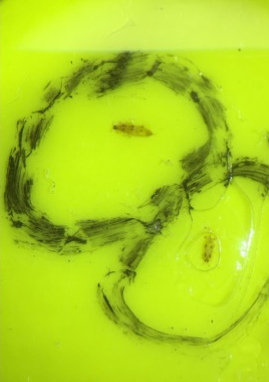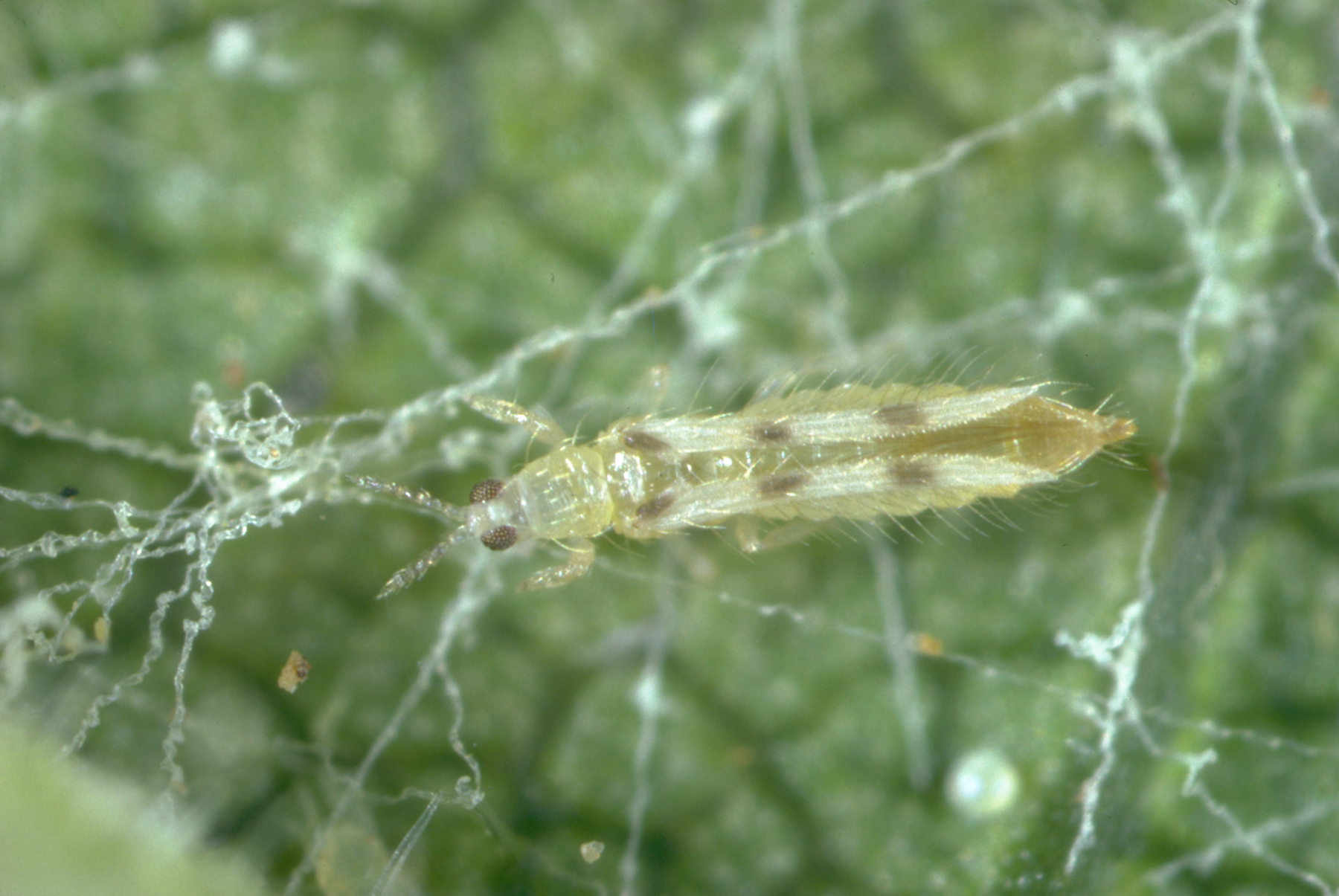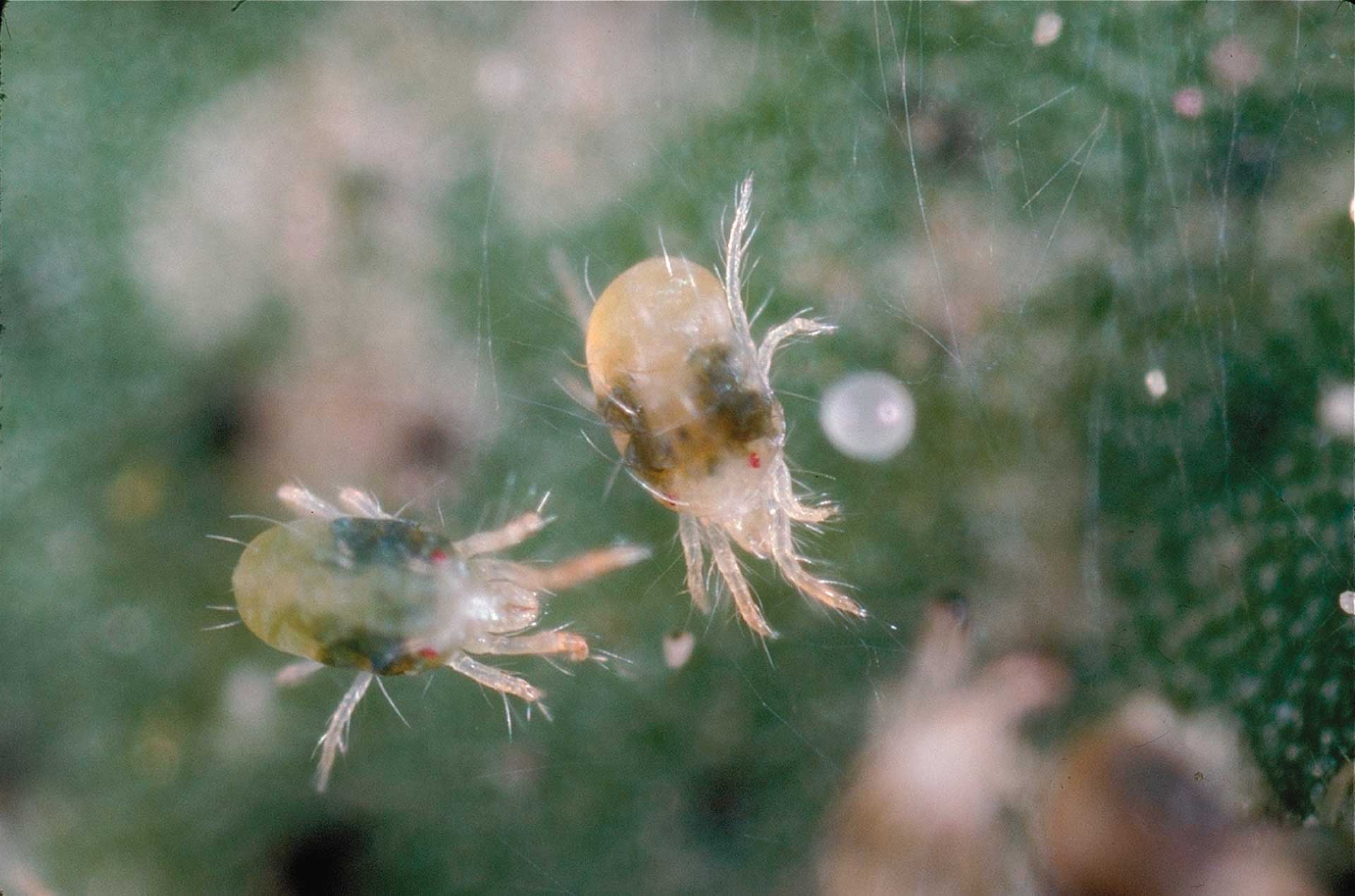Decision support and management tools for insect pests in walnuts and almonds continue to be refined by University of California Cooperative Extension Integrated Pest Management (IPM) specialists and farm advisors.
In research projects over the last few years, UCCE Area IPM Advisor Emily Symmes and UCCE Kern County Entomology Advisor David Haviland have demonstrated effectiveness of using yellow sticky cards in almond and walnut orchards to determine presence and population levels of sixspotted thrips, an important predator of spider mites.
Spider mites are a production concern in walnuts and almonds as very high numbers can cause early defoliation of the trees, reducing nut yield and quality in subsequent years, in addition to interfering with harvest and drying operations in the current year. When present in an orchard, SST feed almost exclusively on spider mites and thrive in spider mite webbing.
Symmes said using yellow sticky cards throughout the growing season to monitor for predator insects is a practice that is being adopted by pest control advisors and growers to back up their visual inspection of leaves for the presence of spider mites and other predators, such as Western predatory mite.
Sixspotted Thrips
Spider mite colonies can build rapidly as summer temperatures begin to rise, trees may experience more water-stress, and dusty conditions become more common in the orchard. Monitoring for their presence as well as predators beginning early in the season (April), and continuing until all spider mite treatment decisions have been made for the season can give growers an idea of the pest pressure in their orchards as well as which predators are present and their abundance. This can help with decisions on whether spray applications are needed and when, as well as inform which pesticides should be used to best protect the predators present. The research project showed that in both almonds and walnuts, the yellow sticky cards proved to be more efficient and a reliable means to for detecting SST and tracking their populations than traditional visual leaf counts (although leaf counts are still necessary to track spider mite and predator mite populations).
In orchards, spider mite colonies develop on the underside of leaves. Once hot weather sets in, mites reproduce rapidly and can produce many generations per year.
Spider mite predators can keep spider mites under control, depending on the populations of each. Sixspotted thrips can be effective in reducing high numbers of spider mites, but can be late to the game, especially if disrupted early in the season, moving into orchards only when mite populations are high. Both the adult and juvenile SST stages prey on spider mites.

Research done by Haviland in almonds in the southern San Joaquin Valley suggests that each SST consumes an average of 50 spider mite eggs per day at 86 degrees F. Populations levels of SST can double at twice the rate of spider mites. The average for spider mites is 7.6 days and 3.4 days for SST. This allows for rapid SST population increase and significant potential for reducing spider mite loads.
Symmes said the yellow sticky cards are effective for monitoring seasonal population growth of SST. The cards are double sided and tacky. Both large and small size cards were used in the walnut research project. The larger cards measured 6 by 12 inches and the smaller ones 3 by 5 inches. The larger size cards provided slightly higher pest detection rates, but Symmes said that using more of the smaller cards is a good option because they are easier to work with. Great Lakes IPM and Trece both carry the cards.
Symmes noted that there was no significant difference between the numbers of SST detected on cards hung high in the tree canopy and the cards placed on lower branches in walnuts. This differs from the standard practice of monitoring with sticky cards for codling moth and walnut husk fly by placing them high in the canopy, and can make using the cards for SST monitoring more efficient.
More data will be collected in future walnut work, examining several additional factors. Those include placement of yellow sticky cards in the orchard (border rows, middle or hot spots), variability in monitoring method efficiency at different SST populations, relationships among orchard, landscape and management feature and SST populations and their impacts on spider mites. Researchers will also validate or refine 2019 data including SST population doubling time and spider mite population doubling time, and numerical impacts of SST on spider mites to predict future spider mite abundance based on SST levels caught on the yellow sticky cards.

The trial is aimed at development of SST monitoring guidelines and best practices, identification of cultural and management practices for growers that can be used to conserve and enhance SST in orchards and the development of economic thresholds for spider mites based on improved SST monitoring practices.
Scale and its Enemies
Another pest to consider monitoring is walnut scale. Symmes said scale became a concern because it predisposes branches to Botryosphaeria infection. Monitoring for the presence of walnut scale and natural enemies can help with determining treatment need and timing spray applications.
Monitoring for scale should be done during the dormant season. It is found in crusted layers on older branches and scaffolds. Walnut scale eggs are laid under the protective cover in spring. The crawlers emerge, find a feeding location, and secrete the waxy cover that protects them. Walnut scale can complete two generations a year.
Treatment timing is important for good scale control. Traditionally, a delayed dormant spray has been used to control scale and cause less harm to beneficial parasitoids. Natural enemies can reduce numbers of walnut scale if they are present in the orchard. Two predators, the twicestabbed lady beetle Chilocorus orbus and anther small beetle, Cybocephalus californicus, can control low numbers of scale. Two parasitic wasps, Aphytis and Encarsia are effective in reducing scale numbers if not disrupted.
Dormant monitoring should be done prior to shoot growth. Double-sided sticky tape can be taped around limbs near adult scale to monitor for crawler emergence and time treatments in spring if delayed-dormant applications were not applied. The tape should be inspected weekly for the presence of crawlers using a magnifying lens, and crawler sprays targeted to peak emergence.
The UC IPM online Pest Management Guidelines provide information about the commonly-used pesticides in the almond and walnut systems and their impacts on natural enemies (predators and parasitoids). When visiting these webpages, look for the link above the treatment table (“the most effective and least harmful to natural enemies, honeybees”) which will send you to a summary table.

Cecilia Parsons
Cecilia Parsons has spent the past 30 years covering agriculture in California for a variety of newspapers, magazines and organizations. During that time she has been fortunate to witness some of the important events that have shaped this diverse industry and worked hard to examine and explain these events for readers.
When Cecilia first moved to the San Joaquin Valley in 1976, her first journalism job was at a small daily newspaper where she covered “farm news.” From there she branched out to writing for a dairy magazine and a regional weekly agriculture publication.
Cecilia is part of a farming family from the rural community of Ducor where she also raises purebred sheep and is attempting to master versatility ranch horse riding.











